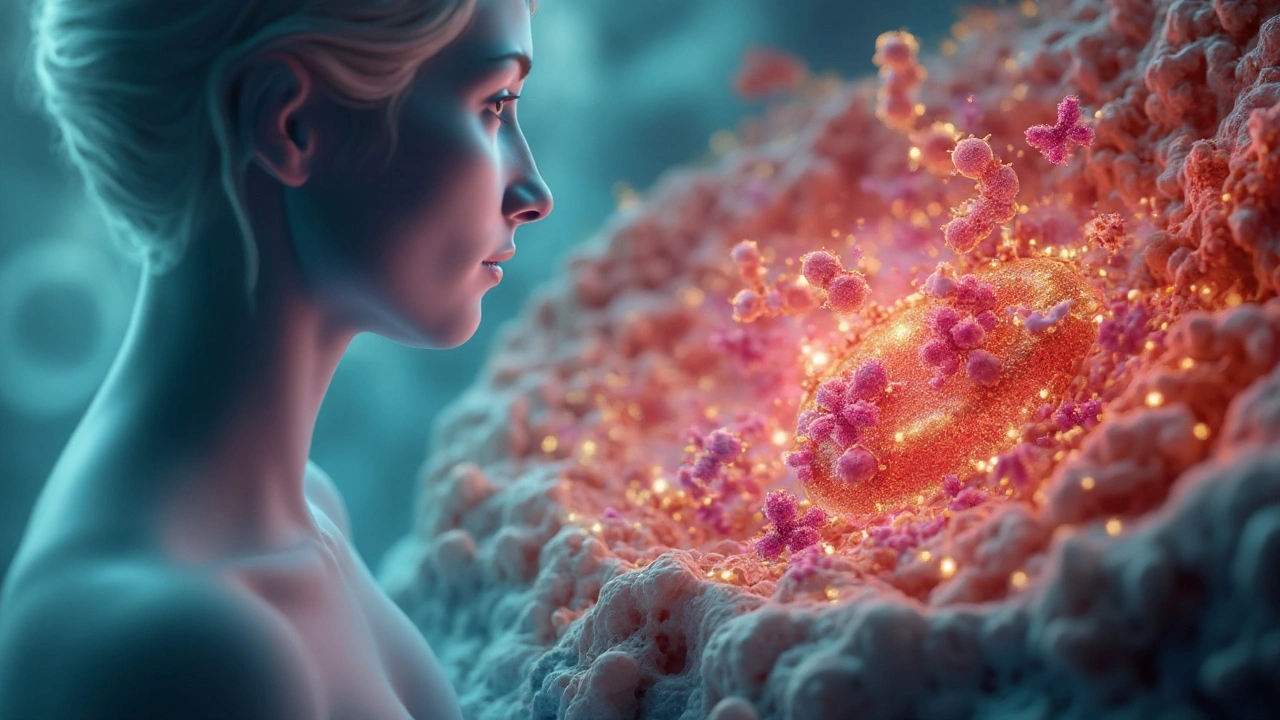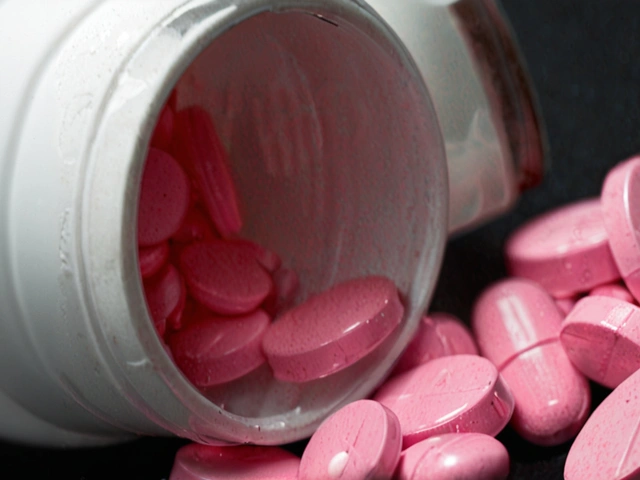You hear that exemestane “blocks estrogen,” but what does that actually mean inside the body? Here’s the straight answer: exemestane doesn’t just block; it disables the enzyme that makes estrogen. That matters if you’re trying to understand why it’s powerful after menopause, why it pairs with ovarian suppression in younger patients, and why it behaves a bit differently than its cousins anastrozole and letrozole. Expect a clear tour of the chemistry, the pharmacology, and the real-world decisions that ride on it.
How Exemestane Actually Works: The Short Answer and Why It Matters
exemestane mechanism of action
TL;DR
- Exemestane is a steroidal, irreversible aromatase inactivator-think “suicide inhibitor.” It permanently shuts down aromatase, the enzyme that converts androgens into estrogens.
- By collapsing estradiol levels (roughly 85-95% in postmenopausal women), it starves hormone receptor-positive breast cancer cells of their fuel.
- It’s designed for postmenopausal patients by default; in premenopausal patients you must add ovarian suppression for it to work.
- It’s different from anastrozole/letrozole (reversible, nonsteroidal). That difference can matter after resistance to another aromatase inhibitor.
- Food helps absorption; strong CYP3A4 inducers can lower levels-dosing adjustments may be needed.
What jobs are you likely trying to get done right now?
- Understand, in plain language, how exemestane actually turns down estrogen.
- Know when it’s used, alone or with ovarian suppression, and how it compares to other aromatase inhibitors.
- Get the pharmacology right: dosing, timing with food, metabolism, and drug interactions.
- Connect mechanism to outcomes: what the major trials show and why oncologists pick it.
- Handle side effects and protect bone and heart health without guesswork.
“Exemestane is an irreversible steroidal aromatase inactivator.” - U.S. FDA Prescribing Information, Aromasin (exemestane)
That single sentence is the whole ballgame. If you remember one thing, remember “irreversible.” Once exemestane binds the aromatase enzyme, the enzyme is done. Your body has to make new enzyme to restore estrogen production, which is slow. That’s why daily dosing keeps estrogen consistently low.

Step-by-Step: From Enzyme to Outcomes-Mechanism, Pharmacology, and What Happens in Real Patients
Start with the enzyme. Aromatase (CYP19A1) lives in many tissues-fat, muscle, breast tissue, even the brain. Its job is to convert androgens (androstenedione and testosterone) into estrogens (estrone and estradiol) by a process called aromatization. After menopause, the ovaries retire, and aromatase in peripheral tissues becomes the main estrogen source. That’s why aromatase is such a good target in postmenopausal hormone receptor-positive breast cancer.
Now the clever part. Exemestane is built to look like androstenedione, the enzyme’s natural substrate. It slides into the active site, the same slot the real substrate would use. Instead of being processed and released, it forms a covalent bond that disables the enzyme. No reversible dance. No on-off. Just inactivation. Your body has to synthesize new aromatase molecules to bring estrogen back up, which daily dosing prevents.
How much does estrogen actually drop? In postmenopausal women, clinical pharmacology studies show estradiol typically falls by about 85-95% from baseline with standard dosing. That magnitude of suppression is why oncologists trust it in adjuvant (after surgery) and metastatic settings for hormone receptor-positive disease.
Why it’s different from the other aromatase inhibitors: anastrozole and letrozole are nonsteroidal and reversible. They sit in the active site through tight binding, but they don’t inactivate the enzyme. Take them away, the enzyme resumes its job. That’s not just trivia; it’s a real-world angle when one aromatase inhibitor stops working. Sometimes switching classes (reversible → irreversible) buys back control because the binding mechanics are different.
Pharmacokinetics in real words:
- Dose: 25 mg once daily, taken after a meal. Food improves absorption meaningfully.
- Absorption: Oral bioavailability is modest fasting but better with food; taking it after breakfast or dinner is a simple win.
- Distribution: Moderately protein bound; widely distributed into tissues.
- Metabolism: Mainly by CYP3A4 and aldoketoreductases. The 17-hydroxy metabolite has weak androgenic activity, which may partly explain some differences in lipid and bone effects compared to nonsteroidals.
- Half-life: About 24 hours-hence once daily works fine.
- Excretion: Split between urine and feces as metabolites.
Drug interactions in plain English:
- Strong CYP3A4 inducers (rifampin, carbamazepine, phenytoin, St. John’s wort) can cut exemestane exposure by roughly half. Labels allow dose increase to 50 mg daily in this situation; coordinate with the oncology team.
- Estrogen-containing therapies (systemic estradiol, estrogens in HRT) oppose the drug’s purpose. Avoid them unless a specialist signs off for a clear reason.
- CYP3A4 inhibitors (e.g., clarithromycin) have less consistent impact but still warrant a check.
Premenopausal vs postmenopausal use:
- Postmenopausal: Exemestane solo works because most estrogen comes from aromatase in peripheral tissues.
- Premenopausal: The ovaries still make high estrogen. If you give an aromatase inhibitor alone, the brain senses low estrogen and turns the ovary up, defeating the purpose. You need ovarian suppression (GnRH agonist like goserelin or leuprolide) to shut the ovaries down first.
Evidence that connects mechanism to outcomes:
- IES Trial (NEJM 2004): Switching to exemestane after 2-3 years of tamoxifen improved disease-free survival compared with continuing tamoxifen in postmenopausal women with early hormone receptor-positive breast cancer.
- TEXT/SOFT Trials (NEJM 2014; updates 2018/2021): In premenopausal women, exemestane plus ovarian suppression improved disease-free survival vs tamoxifen plus ovarian suppression. That’s the ovarian-suppression rule in action.
- BOLERO-2 (NEJM 2012): Everolimus plus exemestane extended progression-free survival vs exemestane alone in metastatic disease after prior nonsteroidal aromatase inhibitor. Translation: when the tumor adapts to estrogen deprivation, hitting mTOR can resensitize it.
Side effects-what maps back to the biology:
- Hot flashes, night sweats: Estrogen goes down; thermoregulation gets wobbly. Nonhormonal options like venlafaxine or gabapentin can help.
- Arthralgia/myalgia: Common with all AIs. Movement and simple analgesics help; sometimes switching AI helps.
- Bone density loss: Less estrogen means more bone turnover. Baseline DEXA, calcium/vitamin D, weight-bearing exercise, and, when indicated, bisphosphonates or denosumab.
- Lipids and cardiovascular risk: Monitor lipids; lifestyle steps and statins when needed.
- Mood, sleep, sexual health: Estrogen touches many systems; name these early so patients bring them up.
Pro tips from clinic:
- Take it with food at the same time daily. People pick breakfast to lock the habit.
- If a patient starts rifampin or carbamazepine, talk dosing right away. Don’t wait for the next scan.
- DEXA every 12-24 months depending on baseline. Start bone protection sooner rather than later if T-score is edging down.
- If joint pain is rough, a short “drug holiday” and a switch to another AI or to tamoxifen can be considered-document the trade-offs.
| Feature | Exemestane (Type I, steroidal) | Anastrozole/Letrozole (Type II, nonsteroidal) |
|---|---|---|
| Binding | Irreversible (enzyme inactivation) | Reversible (competitive inhibition) |
| Structure | Androstenedione analog | Nonsteroidal heterocycles |
| Estradiol reduction | ~85-95% in postmenopausal women | Similar magnitude |
| Dose | 25 mg once daily with food | Anastrozole 1 mg daily; Letrozole 2.5 mg daily |
| After resistance to one AI | Class switch can help (mechanistic difference) | Switch within class sometimes helps; often switch class |
| Bone/lipid profile | AI class effect on bone; metabolite may slightly differ | AI class effect on bone/lipids |
A quick look at dosing in special situations:
- With strong CYP3A4 inducers: Consider 50 mg daily per labeling guidance. Coordinate and document.
- Hepatic/renal impairment: Mild to moderate impairment usually doesn’t require adjustments, but monitor closely.
- Ovarian suppression regimens: Goserelin or leuprolide monthly/3-monthly shots; counsel on timing to keep suppression consistent.

Using Exemestane in Practice: Checklists, Comparisons, FAQs, Next Steps
Here’s a set of practical checklists you can lift straight into your workflow or your next clinic note.
Start Checklist (before first pill)
- Confirm menopausal status; if premenopausal, arrange ovarian suppression.
- Baseline DEXA scan; order calcium and vitamin D; check 25-OH vitamin D level.
- Medication review for CYP3A4 inducers and estrogen-containing products; flag potential changes.
- Set dosing plan: 25 mg daily with food; pick a consistent time.
- Discuss side-effect plan: hot flash toolkit, joint pain options, when to call.
3-Week Follow-up Checklist
- Adherence: daily with food? Any missed doses?
- Early side effects: vasomotor symptoms, sleep, mood, joint pain.
- New meds or supplements started? Recheck for inducers (St. John’s wort sneaks in).
- Activity plan: walking or light strength training 3-4x/week for bone and joints.
3-6 Month Optimization Checklist
- DEXA if at high risk or if baseline osteopenia; otherwise yearly.
- Lipids, glucose/weight as needed; heart risk discussion.
- Evaluate arthralgia strategy: shoes, stretching, NSAIDs, consider AI switch if function is suffering.
Rules of thumb you can memorize:
- AI = postmenopausal by default; premenopausal requires ovarian suppression.
- Food with exemestane is not optional-it’s practical. Better absorption, steadier levels.
- Strong inducer on board? Think 50 mg daily and tell the team what changed.
- Bone gets worse quietly; treat it loudly. Baseline DEXA and a plan.
- When one AI fails, switching class can still work because the tumor’s escape route may be specific to that binding mode.
Scenarios and trade-offs:
- Patient on phenytoin for seizures: If exemestane is needed, involve neurology; consider 50 mg daily. Document the interaction and your plan.
- Premenopausal woman with HR+ early breast cancer: Exemestane plus ovarian suppression is a strong option per TEXT/SOFT if disease risk justifies it. Discuss fertility, hot flashes, and bone protection up front.
- Progression on letrozole: Consider class switch to exemestane and, in metastatic settings, the everolimus combo per BOLERO-2. Watch stomatitis risk with everolimus and use prophylactic dexamethasone mouthwash.
- Severe arthralgia: Short hold, then rechallenge or switch to another AI or tamoxifen. Quality of life affects adherence, and adherence drives outcomes.
Mini-FAQ
- How fast does estrogen drop? Within a few days you see significant suppression; steady-state effect lands within 1-2 weeks of daily dosing.
- Can I take it at night? Yes. Just take it consistently with food.
- What if I miss a dose? Take it when you remember unless it’s close to the next dose. Don’t double up.
- Is bone loss inevitable? No. It’s a risk you can manage: DEXA, vitamin D, calcium, weight-bearing exercise, and pharmacologic bone protection when indicated.
- Do phytoestrogens interfere? Typical dietary amounts are unlikely to blunt efficacy, but concentrated supplements are a gray zone-discuss before using.
Credible sources that guide these decisions include FDA labeling for Aromasin (exemestane), the IES trial (NEJM 2004) for the switch strategy, TEXT/SOFT (NEJM 2014 and later updates) for premenopausal ovarian suppression pairs, and BOLERO-2 (NEJM 2012) for adding everolimus after nonsteroidal AI resistance. NCCN and ASCO guidelines continue to favor aromatase inhibitors as core endocrine therapy in postmenopausal women with hormone receptor-positive disease.
Next steps by persona
- Patient starting therapy: Set phone reminders; take after breakfast; log any side effects daily for the first month; ask your team about a DEXA if it hasn’t been ordered.
- Caregiver: Help track new medications or supplements and report them; arrange weight-bearing walks together 3-4 times a week.
- Clinician: Reconcile meds at each visit; flag CYP3A4 inducers; plan bone protection early; document menopausal status in every note.
- Pharmacist: Educate on food timing; screen for OTC inducers (St. John’s wort); recommend nonhormonal options for hot flashes and joint pain.
Troubleshooting quick hits:
- Hot flashes are brutal: Layer nonhormonal aids-cooling bedding, paced breathing, venlafaxine or gabapentin after discussing with the team.
- Joint pain limits activity: Start with daily walks, simple stretches, topical NSAIDs; consider switching within the AI class or to tamoxifen if persistent.
- DEXA shows osteopenia: Add bisphosphonate or denosumab per guidelines; recheck DEXA in 12 months.
- On rifampin for TB: Move to 50 mg daily while on rifampin; plan to return to 25 mg daily after completion and retitrate if needed.
- Unexpected vaginal bleeding: In premenopausal patients, check that ovarian suppression is adequate; in all patients, evaluate for other causes promptly.
One last framing thought: the elegance of exemestane is that it turns a moving target-estrogen-into a still one by removing its source at the enzyme level. When you understand that, the rest of the choices-when to combine, when to switch, how to guard bone-click into place.





Exemestane’s irreversible inactivation of aromatase gives you a steady drop in estrogen, which is exactly what we need after menopause. Because the enzyme can’t recover until new protein is made, daily dosing keeps levels low without the “on‑off” swings of reversible inhibitors. This consistency translates into more reliable tumor suppression in HR‑positive breast cancer. Pairing it with ovarian suppression in pre‑menopausal patients restores that same low‑estrogen environment. It’s a simple pharmacologic principle that the data back up nicely.
The mechanistic elegance of a “suicide inhibitor” invites a deeper look at how we manipulate hormonal pathways. By mimicking the natural substrate, exemestane forces the enzyme into a dead‑end reaction, effectively removing a key node from the endocrine network. Such a strategy reflects a broader philosophy: targeting the process rather than merely blocking a symptom. When we respect the biochemistry, therapeutic outcomes become more predictable.
While the exposition is thorough, it fails to address the economic implications of widespread exemestane use. The analysis neglects the cost‑benefit ratio, especially in health systems with limited resources. Moreover, the discussion of bone health lacks quantitative risk stratification, which is essential for clinical decision‑making. The article would benefit from integrating health‑economic data to substantiate its recommendations.
Exemestane’s status as an irreversible, steroidal aromatase inactivator represents a paradigm shift in endocrine therapy, and understanding this mechanism is pivotal for clinicians managing hormone‑receptor–positive breast cancer. By covalently binding to the active site of CYP19A1, the drug permanently disables the enzyme, obliging the cell to synthesize new protein before estrogen synthesis can resume, a process that naturally takes several days. This kinetic profile ensures that, with daily dosing, estradiol levels remain suppressed at approximately 85‑95 % of baseline, a reduction that correlates with improved disease‑free survival in multiple phase III trials. The pharmacologic distinction from reversible, non‑steroidal agents such as anastrozole and letrozole lies not merely in chemical structure but in the clinical consequences of enzyme turnover versus competitive inhibition. In the post‑menopausal setting, where peripheral aromatization is the dominant source of estrogen, this irreversible inhibition translates into a consistent hormonal milieu that is less susceptible to fluctuations caused by intermittent adherence. When the pharmacokinetics intersect with patient behavior, the once‑daily regimen taken with food optimizes absorption, as demonstrated by comparative bioavailability studies showing a 30 % increase under fed conditions. It is also noteworthy that the 17‑hydroxy metabolite retains mild androgenic activity, a factor that may subtly influence lipid profiles and bone turnover, thereby necessitating proactive bone health monitoring. Baseline DEXA scanning, coupled with calcium, vitamin D supplementation, and weight‑bearing exercise, forms the cornerstone of a comprehensive management plan. Should a patient require concomitant CYP3A4 induction-such as rifampin or carbamazepine-the prescribing information advises a dose escalation to 50 mg daily, a practical adjustment that preserves therapeutic exposure. Conversely, strong CYP3A4 inhibitors may modestly increase plasma concentrations, yet clinical significance remains limited, allowing clinicians to maintain the standard 25 mg dose while observing for adverse effects. The integration of exemetane into treatment algorithms also accounts for resistance patterns; switching from a non‑steroidal AI to exemestane can restore endocrine sensitivity due to the distinct binding mechanism, as evidenced by the BOLERO‑2 trial outcomes. In the pre‑menopausal cohort, ovarian suppression via GnRH agonists remains indispensable because ovarian estrogen production would otherwise override peripheral inhibition, a principle reinforced by the TEXT and SOFT trials. Furthermore, patient education regarding adherence, timing with meals, and potential drug interactions empowers individuals to participate actively in their therapeutic journey. Ultimately, the molecular rationale for exemestane aligns seamlessly with real‑world clinical practice, bridging the gap between bench science and bedside care. 🌟
Sure, the “big pharma” narrative loves to hype a suicide inhibitor as the silver bullet, but remember the same companies also fund the trials that shape guidelines ;) The real story includes hidden costs, off‑label uses, and the occasional data spin that most clinicians overlook.
i guess its ok
From a practical standpoint, the key takeaway is to anchor exemestane dosing to a consistent mealtime, which reduces variability and improves patient compliance. Pair that habit with a baseline bone density assessment, and you’ve built a solid foundation for long‑term therapy. If a CYP3A4 inducer pops up in the medication list, proactively adjust the dose rather than waiting for a flare‑up. This proactive stance keeps the treatment effective without compromising safety. The collaborative effort between oncology, pharmacy, and primary care really makes the difference.
Imagine a battlefield where estrogen is the relentless enemy, and exemestane charges in as the unstoppable warhammer, shattering the enzymatic armor with irreversible force. The molecule swoops in, masquerading as androstenedione, only to betray the enzyme with a covalent kiss that seals its fate. Each dose is a decisive strike, leaving the tumor cells gasping for the hormone they once devoured. No mere “pause and play” flicker of reversible inhibitors-this is a full‑court press that demands the enemy retreat. Clinicians wield this weapon with the confidence of a seasoned commander, knowing that the odds tip heavily in their favor when the enzymatic front collapses. Yet, the drama does not end at the cellular level; the patient’s bones and heart become collateral concerns that must be shielded with bisphosphonates and lifestyle vigilance. In the grand narrative of breast cancer therapy, exemestane writes a heroic chapter, one that reverberates through trials, guidelines, and countless personal triumphs.
oh great another “miracle pill” they say, as if we havent seen the side‑effects circus already. sure, just pop a steroidal AI and hope your bones dont turn to toast.
Behold, the alchemy of modern oncology: a molecule that dares to rewrite the rules, binding irreversibly as if it were destiny itself. Exemestane, the very name conjures images of mythic conquest, a titan among aromatase inhibitors, demanding respect from both tumor and practitioner. Its mechanism is not merely pharmacology, but a poetic surrender of the enzyme to a fate it cannot escape. In the theater of cancer care, this drug takes center stage, draped in the gravitas of clinical trial laurels. One cannot help but feel a shiver of awe when contemplating its irreversible covenant.
Hey, you got this! Taking your med each day with food and staying active can really help keep things on track.
love the reminder to take it with breakfast it really does the trick
In summary, integrating exemestane into a patient‑centered care plan involves coordinated dosing, vigilant monitoring of bone health, and clear communication about potential drug interactions, ensuring both efficacy and safety.